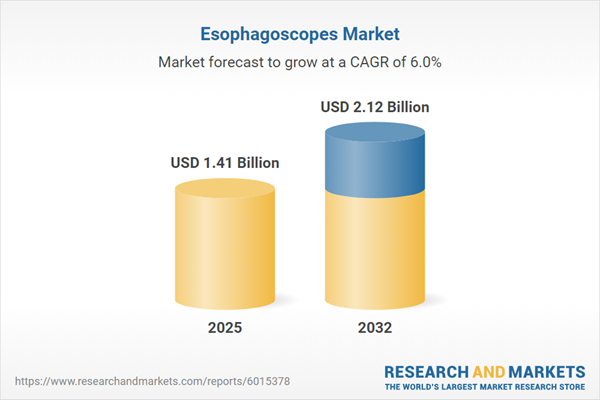Speak directly to the analyst to clarify any post sales queries you may have.
The esophagoscopes market is advancing rapidly as healthcare organizations seek solutions that improve clinical outcomes, enhance regulatory compliance, and deliver operational efficiency. Senior decision-makers are prioritizing assets that support sustainable growth amid shifting healthcare landscapes.
Market Snapshot: Esophagoscopes Market Overview
The Esophagoscopes Market is projected to increase from USD 1.33 billion in 2024 to USD 1.41 billion in 2025, reaching a cumulative value of USD 2.12 billion by 2032, with a compound annual growth rate of 5.99%. Market expansion is being driven by global increases in esophageal disorders, rising demand for minimally invasive diagnostics, and major investment in next-generation endoscopy platforms. Improvements in medical imaging technology and supporting healthcare infrastructure, along with a sharpened focus on patient safety and outcomes, continue to bolster demand. As competition intensifies, organizations are aligning their solutions with both performance and cost-control objectives to maximize outcomes across diverse care settings.
Scope & Segmentation of the Esophagoscopes Market
- Type: Flexible esophagoscopes are available as single-use or reusable models to support infection control objectives and improve procedural turnaround. Rigid esophagoscopes are offered in front- and side-viewing formats to ensure reliability in high-precision interventions.
- Technology: Fiber optic solutions employ image bundles and rod lens systems to provide clear visualization, while video-based optics deliver standard and high-definition imaging for advanced diagnostics and therapy.
- Application: Clinical uses span direct visualization, tissue biopsy, dilation, and stenting. Product durability and accuracy remain critical in supporting both diagnostic and therapeutic pathways.
- Distribution Channel: Products are delivered through direct sales, certified distribution networks, and digital procurement channels, allowing wider market access and operational flexibility.
- End User: Hospitals, clinics, and ambulatory surgical centers each demonstrate unique adoption patterns, influenced by compliance protocols and purchasing processes.
- Region: Growth drivers and demand patterns differ across the Americas, Europe, Middle East & Africa, and Asia-Pacific due to varied manufacturing practices, payment systems, and regulatory landscapes.
- Market Participants: Key industry players include Olympus Corporation, Fujifilm Holdings Corporation, HOYA Corporation, KARL STORZ SE & Co. KG, Richard Wolf GmbH, Ambu A/S, Boston Scientific Corporation, ConMed Corporation, Cook Medical LLC, and Medtronic plc. These organizations focus on product innovation, portfolio diversity, and geographic expansion to address a range of clinical needs.
Key Takeaways for Senior Stakeholders
- Advancements in digital imaging and artificial intelligence improve diagnostic accuracy, supporting integrated workflows and streamlining clinical operations.
- Adoption of single-use flexible esophagoscopes is growing, strengthening infection prevention protocols and enhancing immediate device availability for healthcare facilities.
- Rigid models play a critical role for cases that require consistent performance and greater control, enriching clinical capabilities alongside evolving flexible devices.
- Procurement choices and technology adoption are shaped by diverse local regulations and policies, emphasizing the necessity for tailored compliance and market-entry strategies by region.
- Modular device design and scalable digital capabilities—often achieved through strategic collaborations—allow manufacturers to address changing requirements in clinical and operational settings.
- Partnerships and joint ventures expand market presence and facilitate access to advanced solutions, especially in regions experiencing accelerated sector growth.
Tariff Impact and Supply Chain Adaptation
The introduction of updated U.S. tariffs on imported medical devices has driven manufacturers to restructure supply chains. Increased component costs have led the sector to prioritize local assembly and deepen domestic supplier relationships. Healthcare providers are adapting by renegotiating contracts and diversifying procurement strategies to ensure access and manage spending.
Methodology & Data Sources
This market analysis is built on broad secondary research—spanning medical literature and regulatory publications—complemented by direct expert interviews and focused industry surveys. Findings have been rigorously validated, enabling strategic stakeholders to act on proven insights in the esophagoscopes market.
Why This Esophagoscopes Market Report Matters
- Enables executive teams to optimize investment and purchasing strategies using robust, region-specific segment analysis tailored to organizational objectives.
- Clarifies how regulatory and tariff changes influence operational tactics and cost management, supporting effective risk mitigation and long-term planning.
- Presents actionable insights on emerging technology trends, supporting compliance, competitive agility, and strategic planning across both clinical and administrative workflows.
Conclusion
This report empowers senior leaders with actionable market intelligence to inform growth strategies, drive operational improvements, and adapt investment approaches for a dynamic esophagoscopes landscape.
Additional Product Information:
- Purchase of this report includes 1 year online access with quarterly updates.
- This report can be updated on request. Please contact our Customer Experience team using the Ask a Question widget on our website.
Table of Contents
3. Executive Summary
4. Market Overview
7. Cumulative Impact of Artificial Intelligence 2025
Companies Mentioned
The companies profiled in this Esophagoscopes market report include:- Olympus Corporation
- Fujifilm Holdings Corporation
- HOYA Corporation
- KARL STORZ SE & Co. KG
- Richard Wolf GmbH
- Ambu A/S
- Boston Scientific Corporation
- ConMed Corporation
- Cook Medical LLC
- Medtronic plc
Table Information
| Report Attribute | Details |
|---|---|
| No. of Pages | 188 |
| Published | October 2025 |
| Forecast Period | 2025 - 2032 |
| Estimated Market Value ( USD | $ 1.41 Billion |
| Forecasted Market Value ( USD | $ 2.12 Billion |
| Compound Annual Growth Rate | 5.9% |
| Regions Covered | Global |
| No. of Companies Mentioned | 11 |









